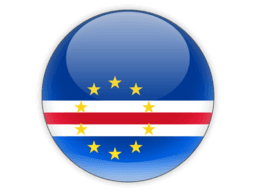
Regions of Cape Verde
Explore 22 regions
Cities of Cape Verde
Discover 22 cities across 20 regions
Boa Vista(1)
Paul(1)
Porto Novo(1)
Praia(1)
Ribeira Brava(1)
Ribeira Grande de Santiago(1)
Santa Catarina(1)
Santa Catarina do Fogo(1)
Santa Cruz(2)
São Domingos(1)
São Filipe(1)
São Lourenço dos Órgãos(1)
São Miguel(1)
São Salvador do Mundo(1)
São Vicente(1)
Tarrafal(1)
Tarrafal de São Nicolau(1)
Cape Verde is a group of islands located off the coast of West Africa, in the Atlantic Ocean. The country consists of ten main islands and several smaller islets, and has a population of around 550,000 people. The official language is Portuguese, and the country has a rich mix of African and European cultural influences.
The economy of Cape Verde is largely based on services, including tourism, and agriculture, with the main crops being bananas, corn, and beans. The country is known for its beautiful beaches, vibrant music and cultural scene, and friendly people. Cape Verde has a diverse mix of cultures, with African, European, and Brazilian influences, and its music and dance traditions are famous worldwide.
Cape Verde is a democratic republic, with a president as the head of state and a prime minister as the head of government. The country is divided into 22 municipalities and is known for its stability and peaceful political climate. However, Cape Verde faces challenges related to poverty, unemployment, and climate change.
Cape Verde is located in a region of the Atlantic Ocean that is susceptible to drought and other natural disasters. The country has been working to address these issues through investment in renewable energy and water management, as well as through partnerships with international organizations and other countries in the region.
Overall, Cape Verde is a beautiful and unique country with a rich cultural heritage and a growing economy. While it faces challenges related to poverty and climate change, the country is working to address these issues and improve the lives of its people.
National holiday
Independence Day, 5 July (1975)
Telephone Code
238
Local Emergency Phone
Ambulance: 130; Fire: 131; Police: 132
Vaccinations
An International Certificate of Vaccination for yellow fever is required for travelers arriving from countries with a risk of yellow fever transmission and for travelers having transited through the airport of a country with risk of yellow fever transmission. See WHO recommendations.
Climate
Temperate; warm, dry summer; precipitation meager and erratic
Currency (Code)
Cabo Verdean escudos (CVE)
Electricity/Voltage/Plug Type(s)
230 V / 50 Hz / plug types(s): C, F
Major Languages
Portuguese, Krioulo
Major Religions
Roman Catholic 77.3%, Protestant 4.6%, other Christian 3.4%, Muslim 1.8%
Potable Water
Opt for bottled water
International Driving Permit
Suggested
Road Driving Side
Right
Tourist Destinations
Praia de Santa Maria; Praia de Chaves; Pedra do Lume Salt Crater; Buracona (Blue Eye); Cidade Velha
Major Sports
Soccer, surfing, sailing
Cultural Practices
It is common for people to make a "sssss" sound with their mouth to get your attention. This is not meant to be rude.
Tipping Guidelines
Tip a couple of euros or round up when possible in all situations.
Souvenirs
Carved wooden statues and toys, crocheted items, batik items, native handicrafts including masks, weapons, baskets, and clay items
Traditional Cuisine
Cachupa — a stew made of mashed maize, onions, green bananas, manioc, sweet potatoes, squash, and yams
Geography
Area
total: 4,033 sq km
land: 4,033 sq km
water: 0 sq km
Climate
temperate; warm, dry summer; precipitation meager and erratic
Natural resources
salt, basalt rock, limestone, kaolin, fish, clay, gypsum
People and Society
Population
603,901 (2023 est.)
Ethnic groups
Creole (Mulatto) 71%, African 28%, European 1%
Languages
Portuguese (official), Krioulo (a Portuguese-based Creole language with two main dialects spoken in Cabo Verde and in the Cabo Verdean diaspora worldwide)
Religions
Roman Catholic 77.3%, Protestant 4.6% (includes Church of the Nazarene 1.7%, Adventist 1.5%, Assembly of God 0.9%, Universal Kingdom of God 0.4%, and God and Love 0.1%), other Christian 3.4% (includes Christian Rationalism 1.9%, Jehovah's Witness 1%, and New Apostolic 0.5%), Muslim 1.8%, other 1.3%, none 10.8%, unspecified 0.7% (2010 est.)
Population growth rate
1.19% (2023 est.)
Government
Government type
parliamentary republic
Capital
name: Praia
Economy
Economic overview
tourism-dominated economy benefits from the country’s relative close proximity to Europe; 2009 Financial Crisis halted economic growth for seven years; leveraging export-based growth; COVID-19 decimated economic growth and recovery; high external debt
Real GDP (purchasing power parity)
$3.595 billion (2021 est.)
Real GDP per capita
$6,100 (2021 est.)
Agricultural products
sugar cane, tomatoes, bananas, cabbages, coconuts, cassava, pulses, vegetables, milk, goat milk
Industries
food and beverages, fish processing, shoes and garments, salt mining, ship repair
Exports
$459.923 million (2021 est.)
Exports - partners
Spain 65%, Portugal 14%, Italy 8% (2019)
Exports - commodities
processed and frozen fish, mollusks, clothing, scrap iron (2019)
Imports
$1.117 billion (2021 est.)
Imports - partners
Portugal 36%, Netherlands 16%, Spain 11%, China 6% (2019)
Imports - commodities
refined petroleum, delivery trucks, coal tar oil, cars, rice (2019)
International Airports in Cape Verde
Discover 6 major airports serving Cape Verde
Mark Cape Verde as Visited
Add Cape Verde to your personal travel map and track your journey around the world. Share your adventures and see your progress grow!